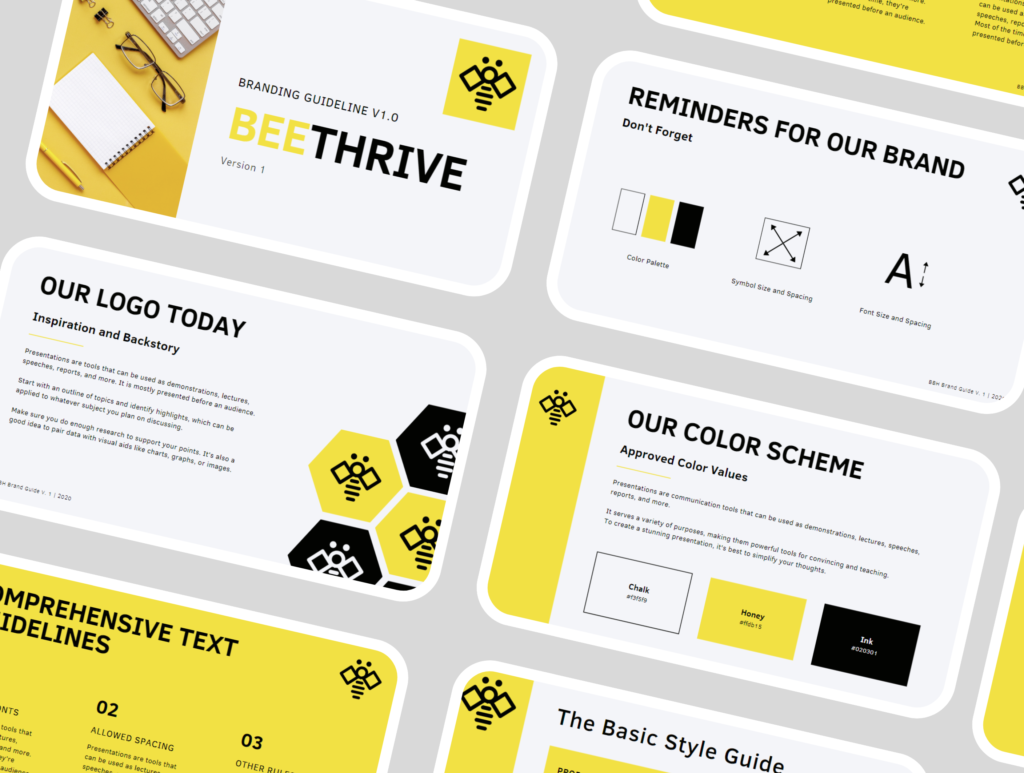Introduction to Branding Guidelines
Branding Guidelines: A Foundation for Your Business
Branding guidelines, also known as brand standards or brand manuals, are essential documents for any business. They articulate the unique identity and personality of the brand. These guidelines outline key elements that communicate the brand’s values, vision, and mission, ensuring consistency across all visual and verbal expressions.
A comprehensive set of branding guidelines typically covers various components, including:
- Logo Usage: Clear instructions on how to use your logo.
- Color Palettes: Defined colors that represent your brand.
- Typography: Fonts and styles to maintain uniformity in written communication.
- Imagery: Guidelines on images and graphics associated with your brand.
- Tone of Voice: The style in which you communicate verbally or in writing.
The Importance of Effective Branding Guidelines
Establishing effective branding guidelines is crucial for maintaining brand integrity across various platforms, including digital, print, and in-person marketing. When teams follow these guidelines, they create a cohesive representation of the brand, enhancing recognition and trust among customers. As businesses evolve, it’s essential to update branding; stagnant guidelines can lead to a diluted brand image and miscommunication with target audiences.
Moreover, as market dynamics shift, businesses may need to redesign branding approaches or adapt their strategies to remain relevant. Updating branding guidelines can facilitate adjustments that reflect current trends, audience preferences, and advancements in technology. The ability to pivot and refresh branding not only enhances public perception but also strengthens internal culture by aligning all stakeholders with a unified vision. As we explore compelling reasons to update branding guidelines, it’s vital to recognize that these updates are not merely cosmetic, but rather an essential evolution of the brand’s voice and presence in a competitive landscape.
Evolving Market Trends
The business landscape is continuously influenced by an array of factors that can shift market dynamics profoundly. As consumer preferences evolve, technological advancements emerge, and competitive landscapes change, it is imperative for businesses to stay attuned to these market trends. One crucial aspect of maintaining relevance in such a fluid environment is the necessity of updating branding guidelines. These guidelines serve as a framework that reflects not only a company’s core values but also its adaptability in the face of shifting trends.
For example, consider industries such as fashion and technology, where branding must keep pace with rapid changes. In the fashion sector, brands that fall behind in updating their branding often find themselves unable to attract new customers. Companies such as Zara and H&M have successfully rebranded to align with sustainable practices, helping them connect with a more eco-conscious demographic. Similarly, in technology, firms like Apple have continually redesigned their branding to reflect innovative advancements and consumer expectations, reinforcing their market dominance.
The significance of adapting business branding guidelines cannot be overstated. An updated branding guide not only ensures that visual elements are modern and appealing but also acknowledges shifts in target audience behavior. This becomes especially relevant in an increasingly digital marketplace, where the effectiveness of branding directly influences customer engagement. Organizations must remain vigilant and proactive, continuously monitoring industry developments to inform their branding strategy. By embracing the need to update branding, businesses can secure a competitive edge, respond to industry changes effectively, and position themselves as relevant and appealing to their customers.
Understanding Changes in Target Audience
As businesses evolve, so do their target audiences. The demographic and psychographic landscapes shift due to various factors such as technological advancements, cultural trends, and socio-economic changes. Consequently, it becomes imperative to regularly assess and update branding guidelines to align with the current needs and values of both existing and potential customers. Understanding these changes is crucial to staying relevant in a competitive market.
Consumer behavior is an area that warrants meticulous analysis. As preferences evolve, businesses must adapt their branding strategies accordingly. For instance, data gathered from market research can unveil shifts in consumer expectations, demonstrating a preference for sustainable practices, diverse representation, and personalized experiences. Ignoring such trends might result in a disconnect between a brand and its audience, ultimately affecting loyalty and engagement.
Furthermore, the rise of social media and digital platforms allows for more direct and immediate interaction between brands and consumers. These platforms not only facilitate feedback but also highlight changing values and trends in real-time. For businesses, this means that continuous monitoring and updating of branding guidelines are essential. A brand that resonates with its audience today may quickly become outdated tomorrow if it does not evolve alongside its customers.
In this context, updating branding not only involves a visual redesign but also a comprehensive reassessment of the messaging and values the brand wishes to convey. Emphasizing the alignment of branding guidelines with the changing expectations of the target audience can significantly enhance relevance in the market. By fully understanding the evolving landscape and integrating these insights into an updated branding guide, businesses can ensure they connect meaningfully with their audience while fostering brand loyalty.
Brand Refresh Opportunities
Updating branding through a strategic brand refresh provides businesses with numerous advantages, enabling them to maintain relevance and appeal in an ever-evolving market. A well-executed brand update can significantly rejuvenate a brand’s image, attracting new customers while reconnecting with existing ones. A famous example of this is Coca-Cola, which periodically refreshes its branding elements to resonate with current consumer sentiments, resulting in sustained engagement and positive perceptions.
A brand refresh may involve redesigning branding materials, including logos, color schemes, and typography, to reflect recent trends or shifts in company values. For instance, Airbnb’s rebranding efforts focused on fostering community and belonging, leading to heightened brand loyalty. By aligning their visual identity with their mission, they successfully reversed any negative perceptions and boosted their market presence.
The updating branding guidelines during a brand refresh can also help companies tap into new markets or demographics. For instance, when Dunkin’ rebranded as “Dunkin’” and refreshed their logo, they positioned themselves as a modern brand appealing to a younger audience. This not only rejuvenated their coffee images but also significantly increased sales and visibility in competitive markets.
Additionally, a brand refresh allows businesses to communicate changes in their product offerings or innovations. For example, Microsoft’s branding update showcased its transition from traditional software to cloud services. This shift was instrumental in updating customer perceptions, reinforcing their position as an innovator in technology.
In conclusion, the impact of a brand refresh through updated branding guidelines is profound. It can rejuvenate a brand’s image, enhance customer engagement, and ultimately lead to increased sales and market share. By consistently evaluating and redesigning branding elements, businesses can demonstrate their adaptability and commitment to meeting customer needs, ensuring long-term success.
Technological Advancements
The rapid pace of technological advancement has significantly transformed the landscape of business branding. As digital marketing continues to rise, it is imperative for organizations to adapt their branding guidelines accordingly. Updating branding guidelines ensures that businesses remain relevant and competitive in an ever-evolving digital environment. With the proliferation of social media platforms and sophisticated online tools, companies have unprecedented opportunities to engage with their target audiences.
One major aspect of this evolution is the integration of multimedia content into branding strategies. The use of videos, interactive graphics, and engaging visuals has grown tremendously, capturing the attention of consumers more effectively than traditional methods. Therefore, businesses must consider including these elements in their branding guidelines to foster a more dynamic and appealing brand image. Updating these guidelines also involves understanding how different platforms resonate with audiences; each platform may require a unique approach to effectively communicate the brand’s message.
Moreover, technological advancements influence consumer behavior, including their expectations for brand interactions. Customers now anticipate a seamless and personalized experience across various touchpoints. To meet these expectations, businesses should redesign their branding strategies by integrating technology to enhance user experiences. This could involve updating their branding guide to reflect a brand personality that aligns with contemporary consumer values and preferences.
Ultimately, embracing technological advancements in business branding is about seizing new opportunities for engagement and responsiveness. By adapting branding guidelines to include digital strategies, organizations can position themselves to better align with their customer’s needs and preferences in a highly competitive market. In conclusion, updating branding guidelines to reflect the influence of technology is not just beneficial; it is essential for sustained business success.
Consistency Across Channels
In today’s interconnected world, the importance of maintaining a cohesive brand image cannot be overstated. Consistency across various channels—such as online platforms, print materials, and social media—is crucial to how a brand is perceived by its audience. When businesses undertake the task of updating branding, it is vital to ensure that branding guidelines reflect a unified approach to visual identity and communication style. This consistency enhances brand recognition and fosters trust among consumers.
Updated branding guidelines serve as the foundation for all marketing and communication efforts. They dictate not only the use of logos, colors, and typography but also the tone and style of messaging. By adhering to these guidelines, businesses can present a professional image that resonates with their target audience. For instance, a company that uses the same color palette and logo across its website, social media profiles, and printed materials will reinforce its identity, making it easily recognizable and memorable.
The absence of a cohesive branding strategy can lead to confusion, with customers struggling to identify the brand across different channels. Updated branding guidelines help mitigate this risk by providing clear directives for every touchpoint. This includes digital content, advertisements, packaging, and customer service interactions. By ensuring that all elements align, businesses not only establish a distinct brand identity but also enhance the overall customer experience.
Ultimately, the process of redesigning branding to establish consistency across channels is an investment in the brand’s future. It ensures that all stakeholders—employees, customers, and partners—understand and connect with the brand in a unified manner. This alignment is integral to building lasting relationships and fostering brand loyalty, which in turn contributes to the overall success of the business.
Addressing Legal and Compliance Issues
In the realm of business branding, it is crucial to consider the legal implications that arise from the use of visual and textual elements. Brands must navigate a complex landscape of trademarks and copyright regulations to protect their intellectual property and avoid legal disputes. An effective approach to mitigating these risks involves regularly updating branding guidelines to ensure compliance and maintain legal protections.
Trademarks safeguard unique identifiers that represent a brand, such as logos, slogans, and product names. If your branding elements are outdated or not properly registered, your business may become vulnerable to infringement claims from competitors or third parties. By redesigning branding assets according to updated branding guidelines, you can reinforce your legal rights while enhancing your brand’s distinctiveness in the market.
Additionally, copyright laws play a significant role in protecting original works, including images, videos, and written content. Failure to comply with copyright regulations could result in costly lawsuits or the need to alter branding assets retroactively. Establishing comprehensive business branding guidelines can help safeguard your brand’s creative output, ensuring that all visual and editorial content aligns with copyright laws.
Moreover, regulations in various industries may dictate how brands communicate with their audiences, necessitating updates to branding guides. For instance, healthcare and financial services brands often face stringent advertising and disclosure requirements. Updating branding guidelines to accommodate legal and compliance considerations will not only minimize risks but will also enhance consumer trust in your brand. By proactively addressing these legal aspects, businesses can effectively protect their brand identity and foster long-term growth.
Enhancing Employee Alignment and Engagement
Updating branding guidelines can significantly enhance employee alignment and engagement within an organization. When an enterprise refreshes its brand identity, it often entails a reassessment of its core values, mission, and vision. Clarity in these elements is paramount, as it equips employees with a precise understanding of what the brand stands for. Enhanced comprehension fosters a stronger connection to the organization’s objectives, ensuring that team members are not just aware of the brand but are also emotionally invested in it.
Clear and comprehensive business branding guidelines serve as a framework that employees can rely upon in their day-to-day activities. When individuals understand the nuances of the brand identity—the look, feel, and messaging—they can better represent the brand in their interactions, both internally and externally. This understanding engenders pride in the brand, as employees feel they are ambassadors of a well-defined and purpose-driven organization.
Additionally, when updates are communicated effectively, employees are more likely to engage with the branding efforts enthusiastically. Regular training sessions, workshops, and accessible resources on the updated branding guide can provide staff with the tools they need to embody the brand values consistently. This initiative can cultivate an internal culture that celebrates the brand’s mission, ultimately translating into better customer interactions and external representation.
The alignment achieved through revitalized branding guidelines also stimulates collaboration among teams. Employees who understand and share the same branding principles are more likely to work harmoniously and innovate effectively, as they are united by a common purpose. In essence, the process of redesigning branding not only revitalizes the company’s external image but also reinforces a cohesive internal culture that supports employee engagement and alignment.
Maintaining Competitive Advantage
In the fast-paced landscape of contemporary business, maintaining a competitive advantage is essential for long-term success. One pivotal aspect of achieving this is through the regular updating of branding guidelines. When a company consistently reviews and adapts its branding, it positions itself to respond effectively to both market dynamics and competitor movements.
Competitors are continually evolving their branding strategies in response to consumer preferences and emerging market trends. By keeping an eye on these changes, businesses can identify shifts in the industry and strategically adjust their own branding guidelines accordingly. Whether it’s through a subtle redesign of branding elements or a more comprehensive overhaul, staying attuned to industry shifts allows a company to align its branding with current consumer expectations and perceptions.
Furthermore, updating branding serves as a signal to stakeholders, customers, and even employees that a business is proactive and aware of its market position. A brand that is perceived as static may risk being disconnected from its audience, which can lead to reduced market share. By contrast, companies that regularly refresh their branding can resonate more deeply with their target demographics, fostering loyalty and attracting new customers.
Another advantage of consistently updating the branding guide is the potential for innovation. A refreshed approach to business branding encourages fresh ideas and creative strategies that can differentiate a company from its competitors. Businesses that invest in understanding their competitive landscape and promptly adapting their branding strategies are more likely to sustain their market position and achieve their growth objectives.
In conclusion, regularly updating branding guidelines is not merely an exercise in aesthetics; it is a strategic imperative that can help maintain a competitive edge in an ever-evolving marketplace. By being responsive to competitors and adjusting branding as needed, businesses can not only survive but thrive in their respective industries.
The Role of Feedback and Continuous Improvement

In the context of updating branding, one of the most valuable assets a business can possess is feedback from customers and stakeholders. This feedback acts as a catalyst for continuous improvement, which is crucial for any brand striving to remain relevant and appealing in a constantly changing marketplace. When businesses actively seek input on their branding strategies, they not only gain insights into their current perception but also foster a sense of community and engagement among their audience.
Establishing a structured channel for collecting feedback can lead to significant enhancements in branding guidelines. Whether it is through surveys, focus groups, or social media interactions, understanding how consumers perceive your brand and what aspects resonate with them can inform necessary changes. Feedback can illuminate areas where branding may fall short, allowing for timely adjustments rather than waiting for drastic measures later down the line.
Brands that prioritize feedback are more likely to experiment with new ideas while also maintaining a core identity that their audience connects with. In doing so, organizations demonstrate their commitment to quality and customer satisfaction, which enhances loyalty and trust in their brand. Ultimately, the ongoing cycle of collecting feedback and implementing changes forms a crucial part of maintaining robust and effective business branding guidelines that can stand the test of time.



